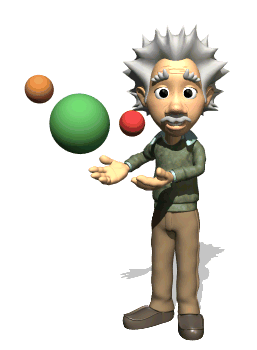
Einstein's Relativity
Albert Einstein was puzzled by the concept of relative motion, especially when applied to situations of electromagnetic and gravitational forces. Einstein postulated that there are no instantaneous reactions in nature, therefore there must be a maximum possible speed for any reaction, which is the speed of light in a vacuum (c). Further, the speed of light in the vacuum must be the same for all observers, whether moving or at rest.
Einstein felt confident of these postulates, but soon realized that the repercussions of these postulates would upset the foundations of the known physical world. Eventually, he realized that the only way his postulates could be true in all situations involved a re-imagining of the concept of time, detailed in his proposal of Special Relativity. To begin with, events that appeared to occur simultaneously in one frame of reference did not necessarily occur simultaneously in another frame of reference. The entire concept of simultaneous events was relative!
More specifically, observers moving at different speeds would experience different time intervals. Imagine a modern training traveling at high speed. A laser, in the exact center of the train, turns on and shoots a laser beam toward the front and the back of the train. An observer in the center of the train car would see the laser beams would hit the front and back windows of the train simultaneously. An observer on a lawn chair outside the train watching the train pass by, however, would see the laser exit the back window of the train first, since the back of the train is moving to meet the laser beam, while the front of the train is moving away from the laser beam. The observer outside the train does not see simultaneous events, while the observer inside the train does see simultaneous events. Time is therefore relative to the observer.
The implications of these findings are wide-spread and complex. Objects traveling at high velocities relative to an observer experience what is known as time dilation. What is experienced as a short time interval by the high-speed object is experienced as a longer time interval by the observer.

A famous thought experiment involves two identical twins on Earth. Suppose one twin leaves Earth at the age of 20 in an imaginary spaceship and travels at 90% of the speed of light (0.9c) a distance of 10 light years, then turns around and returns to Earth. The second twin remains on Earth. The space-faring twin returns having experienced a trip of just under 20 years time (under 20 years due to some other secondary relativistic effects), and has aged 20 years, returning as a 40-year-old, while the twin who remained on Earth experienced roughly 44 years while the sibling was in space, and is now 64 years old.
Further, as objects travel at higher speeds, their length contracts compared to the stationary observer. Further yet, as objects move faster and faster, it takes more and more energy to accelerate them further, therefore mass can never be accelerated to the speed of light.
Einstein generalized his work in the Theory of General Relativity, where he proposed that space and time are intertwined in a universal fabric known as spacetime. Large masses have the ability to bend the fabric of spacetime, leading to what you experience as gravity.
If all this sounds a bit complex and confusing, you’re not alone. Entire courses and careers have been devoted to exploring and debating these theories. Thankfully, it is easy to find more resources on relativity, both on the web and in print form, written in a variety of formats from illustrated comics to complex mathematical proofs.
Most importantly, these developments serve as a great reminder that despite how much scientists think they know about the universe, there is much more that is yet unknown, and therefore so many more explorations to be undertaken and discoveries to be made that physics continues to grow and evolve on a daily basis.

